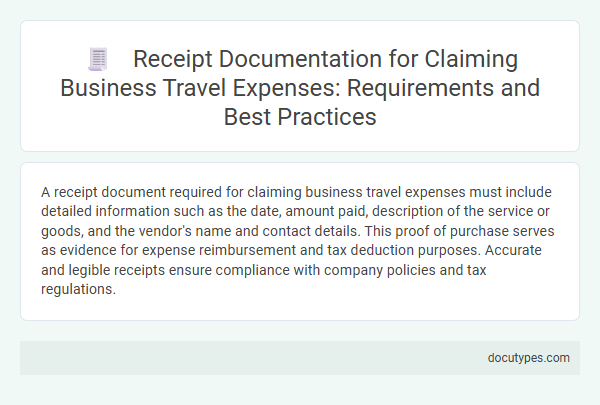A receipt document required for claiming business travel expenses must include detailed information such as the date, amount paid, description of the service or goods, and the vendor's name and contact details. This proof of purchase serves as evidence for expense reimbursement and tax deduction purposes. Accurate and legible receipts ensure compliance with company policies and tax regulations.
Introduction to Receipt Documentation for Business Travel Expenses
Receipts serve as essential proof for business travel expenses when submitting claims. Accurate receipt documentation ensures compliance with company policies and tax regulations.
- Original Receipt - Your business travel expense claim requires the original receipt showing date, vendor, and amount.
- Detailed Description - The receipt must include a clear description of the purchased goods or services related to travel.
- Compliance with Policy - Only receipts that meet your organization's travel expense policy criteria will be accepted for reimbursement.
Importance of Accurate Receipt Management
Receipts are essential documents for substantiating business travel expenses during reimbursement claims. Proper receipt management ensures accurate financial records and compliance with company policies and tax regulations.
- Proof of Expense - Receipts provide verifiable evidence of transactions incurred during business travel, supporting legitimate claims.
- Financial Accuracy - Accurate receipts prevent discrepancies in expense reports, facilitating precise accounting and budgeting.
- Audit Compliance - Maintaining organized receipts helps satisfy internal audits and regulatory requirements, reducing risk of penalties.
Effective receipt management streamlines the expense claim process and upholds financial integrity for businesses.
Types of Receipts Required for Business Travel Claims
A receipt document required for claiming business travel expenses must include detailed transaction information such as the date, amount, vendor name, and description of goods or services. Common types of receipts for business travel claims are airline tickets, hotel invoices, car rental agreements, and meal receipts, each serving as proof of expenditure. Your submitted receipts should clearly demonstrate the nature and purpose of the travel expense to ensure successful reimbursement.
Essential Information Every Receipt Should Contain
What receipt document is required for claiming business travel expenses? A valid receipt must clearly show the date of the transaction and the vendor's name. It should also include an itemized list of purchased goods or services with their corresponding prices.
Digital vs. Paper Receipts: Pros and Cons
| Receipt Document Type | Description | Pros | Cons |
|---|---|---|---|
| Paper Receipt | Physical, printed proof of payment issued at the point of sale for business travel expenses, including transportation, lodging, and meals. |
|
|
| Digital Receipt | Electronic version of the receipt sent via email, mobile apps, or generated through digital payment systems for business-related travel costs. |
|
|
Organizing Receipts for Easy Expense Reporting
A detailed receipt document is essential for claiming business travel expenses, as it verifies the nature and amount of the expenditure. Organizing receipts by date, vendor, and category ensures faster and accurate expense reporting. Maintaining a systematic filing system reduces the risk of lost receipts and simplifies the reimbursement process.
Common Documentation Mistakes to Avoid
A receipt document required for claiming business travel expenses must clearly show the date, amount, and nature of the expense. Essential details include the vendor's name and a description that matches the reported business activity.
Common documentation mistakes to avoid include submitting illegible or partial receipts that lack critical information. You should ensure all receipts are original and fully itemized to prevent claim rejections or delays.
Best Practices for Submitting Receipts with Expense Claims
A receipt document required for claiming business travel expenses must clearly show the vendor's name, date of purchase, and amount paid. This ensures accurate verification and compliance with company policies and tax regulations.
Best practices for submitting receipts with expense claims include attaching original or digital copies that are legible and complete. Organize receipts by date and match them with corresponding expense entries in the claim form to avoid delays. Always include a brief description or purpose of the expense to provide context for the approval process.
Compliance with Company and Tax Regulations
A receipt document required for claiming business travel expenses must clearly detail the date, amount, and vendor information to ensure compliance with company policies and tax regulations. Proper documentation supports audit trails and validates the legitimacy of your expense claims.
Receipts should include itemized charges and be original or digital copies accepted by tax authorities to meet legal standards. Maintaining compliant receipts helps avoid reimbursement delays and potential tax penalties for the business.
What Receipt Document Is Required for Claiming Business Travel Expenses? Infographic

